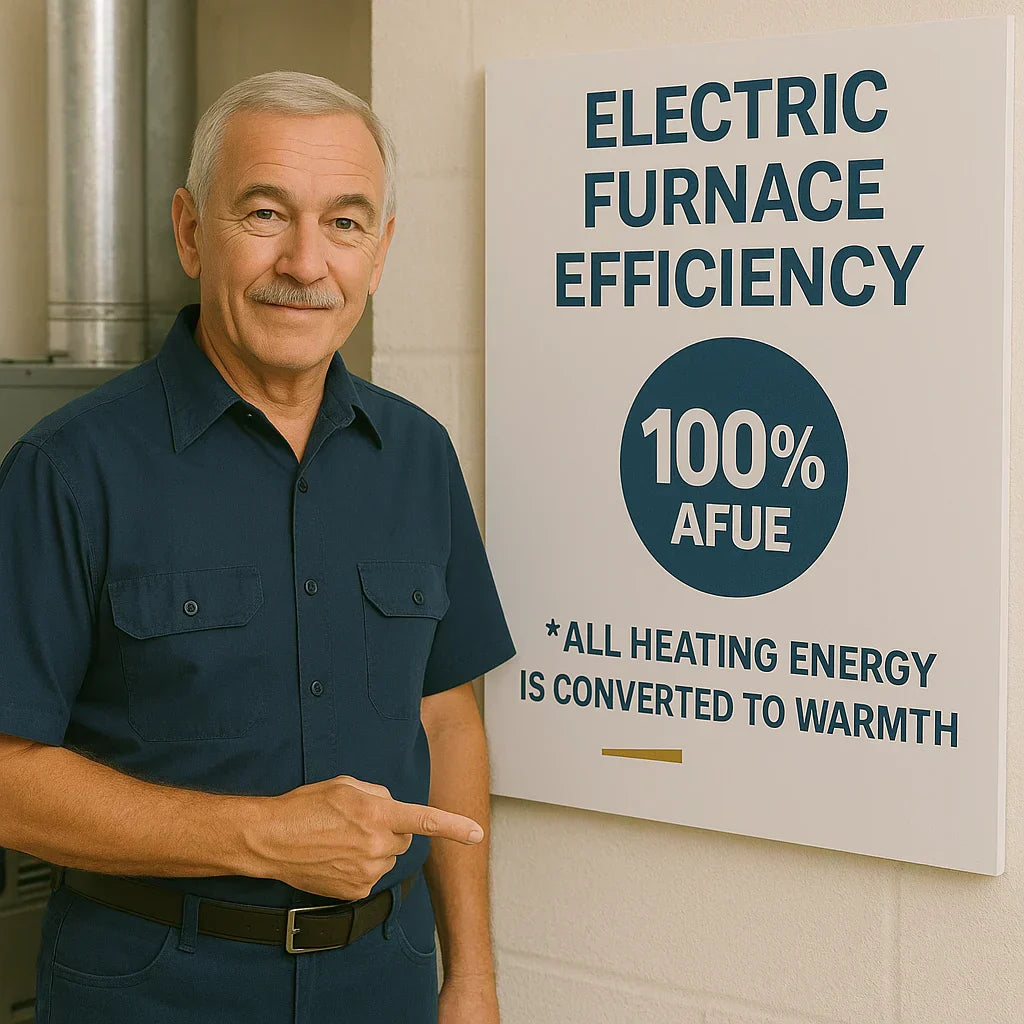🏡 Introduction: The "Perfect Efficiency" Myth Explained
When shopping for an electric furnace, you’ll see one number come up again and again: 100% AFUE. Sounds great, right? But what does that actually mean for your energy bill? Is an electric furnace truly 100% efficient? Tony Marino breaks it all down in this no-nonsense guide to help you understand real-world operating costs, efficiency ratings, and how electric furnaces compare to gas models.
🔄 What Is AFUE? A Quick Refresher
-
AFUE = Annual Fuel Utilization Efficiency
-
It measures how much of the input energy is converted into usable heat for your home.
-
Example: 80% AFUE means 80% of the energy becomes heat, 20% is lost.
-
All electric furnaces list an AFUE of 100% because no heat is lost through venting or combustion.
🌍 Why Electric Furnaces Are 100% AFUE
-
Electricity is converted directly into heat via resistance coils.
-
No combustion gases to vent outside.
-
Every kilowatt of electricity produces 3,412 BTUs of heat.
-
No flue losses, no wasted heat in the exhaust.
Energy Star - Electric Heating Efficiency
🔧 But Is 100% AFUE The Whole Story?
-
Yes, electric furnaces are 100% efficient inside the unit.
-
BUT electricity generation itself may not be 100% efficient:
-
Power plant generation (coal, natural gas, nuclear, hydro, solar)
-
Transmission line losses (5%-10% in most grids)
-
Distribution inefficiencies
-
-
So the total "source-to-site" efficiency is often much lower.
EPA - Source Energy vs Site Energy
🌧️ Electricity vs. Gas: A Real Cost Comparison
| Fuel Type | Efficiency (AFUE) | Cost per BTU (Average 2025) |
|---|---|---|
| Electric Furnace | 100% | $0.015 - $0.025 per kWh equivalent |
| High-Efficiency Gas | 95% | $0.006 - $0.010 per BTU equivalent |
-
Even though electric furnaces are 100% AFUE, electricity usually costs more per unit of heat than natural gas.
U.S. Energy Information Administration - 2025 Energy Prices
🌬️ Regional Electricity Cost Differences Matter Tremendously
| Region | Average Residential Electric Rate (2025) |
| Pacific Northwest | $0.12/kWh (lots of hydro power) |
| Midwest | $0.16/kWh |
| Northeast | $0.20/kWh |
| South | $0.14/kWh |
| California | $0.25/kWh (high demand, grid issues) |
U.S. EIA Electric Rates by State
🔓 How Insulation and Air Sealing Multiply Efficiency
-
Even a 100% efficient furnace wastes money if your home leaks heat:
-
Drafty doors
-
Poorly sealed attic spaces
-
Leaky ductwork
-
Uninsulated basements or crawlspaces
-
-
Air sealing and insulation improvements often allow you to downsize furnace capacity and slash bills.
Energy Star - Home Sealing Guidelines
🔧 The Hidden Efficiency Benefits of Modern Electric Furnaces
-
Variable speed ECM motors use up to 60% less electricity than traditional PSC motors.
-
Zoned electric heating allows selective room-by-room control.
-
Smart thermostats optimize runtime and prevent overuse.
-
Better filtration reduces strain on blowers.
👨💻 Electric Furnaces Shine in Certain Situations
-
Rural homes without natural gas access
-
All-electric homes pursuing solar/net-zero goals
-
Areas with cheap renewable-heavy electric grids (hydro, wind)
-
Safety: No risk of carbon monoxide leaks
-
Lower upfront installation cost compared to gas
Rewiring America - Benefits of Electrification
🏦 Understanding Operating Cost in Real Dollars (2025 Examples)
| Home Size | Furnace Size | Daily Heating Cost (8 hours/day) |
| 1,500 sq ft | 10 kW | $12/day (at $0.15/kWh) |
| 2,000 sq ft | 15 kW | $18/day (at $0.15/kWh) |
| 3,000 sq ft | 20 kW | $24/day (at $0.15/kWh) |
-
Add 20%-30% if electric rates exceed $0.20/kWh.
-
Subtract 20%-40% for well-insulated high-performance homes.
NRDC - Energy Costs and Building Efficiency
🖐 Common Homeowner Misconceptions About 100% AFUE
-
"Electric is always cheaper because it's 100% efficient." (Not always true depending on local rates)
-
"I don’t need insulation since my furnace is efficient." (False)
-
"Old electric furnaces work as well as new ones." (Modern ECM motors, zoning, and smart controls matter!)
-
"I don't need professional maintenance." (Neglect leads to airflow problems and shortened lifespan)
🤓 Tony Marino’s Pro Tips on Electric Furnace Efficiency
-
"Start with insulation and duct sealing first—it's the cheapest way to improve heating costs."
-
"Don’t size your furnace based on square footage alone—get a professional load calculation."
-
"Smart thermostats easily pay for themselves within two years."
-
"If you have solar, an electric furnace may be your best long-term option."
-
"Annual maintenance keeps blowers clean and prevents energy-wasting failures."
📍 Get Efficiency Optimization Help at The Furnace Outlet
Want to ensure you're getting maximum efficiency from your electric furnace? The Furnace Outlet’s expert team can analyze your home’s unique energy needs, insulation status, and electric rates to recommend the most cost-effective electric furnace options. Visit The Furnace Outlet Electric Furnaces Collection to learn more.
In the next topic we will read about: DIY Electric Furnace Installation: Is It Safe and Legal?







